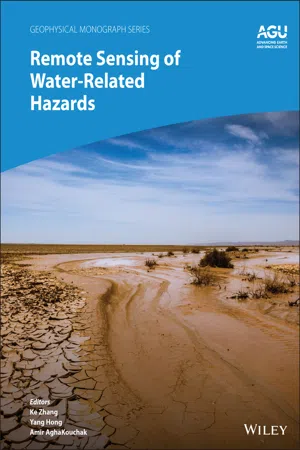
- English
- ePUB (mobile friendly)
- Available on iOS & Android
Remote Sensing of Water-Related Hazards
About This Book
Applications of remote sensing technology for monitoring and predicting water-related hazards
Water-related hazards such as floods and droughts have serious impacts on society. Their incidence has increased in recent decades, a trend set to continue with ongoing climate change. Adaptation and mitigation measures require accurate detection, monitoring, and forecasting, much of which comes from remote sensing technologies.
Remote Sensing of Water-Related Hazards takes an interdisciplinary approach, presenting recent advances in the available data, sensors, models, and indicators developed for monitoring and prediction.
Volume highlights include:
- Progress in remote sensing of precipitation, storms, and tornados
- Different techniques for flood mapping, forecasting, and early warning
- Integrated approach for predicting flood and landslide cascading hazards
- Satellite monitoring of water cycle variation, water scarcity, and drought conditions
- Multi-indicator and multi-sensor approaches for quantifying drought impacts
The American Geophysical Union promotes discovery in Earth and space science for the benefit of humanity. Its publications disseminate scientific knowledge and provide resources for researchers, students, and professionals.
Frequently asked questions
Information
1
Interdisciplinary Perspectives on Remote Sensing for Monitoring and Predicting Water‐Related Hazards
ABSTRACT
Water‐related hazards, including floods, droughts, rainfall‐triggered landslides, water‐scarcity‐induced soil salinization, and other interconnected hazards related to water, have caused considerable loss of human life and damage to property and infrastructure throughout human history. As significant progress has been achieved in satellite technology in recent decades, remote sensing of water‐related hazards has emerged as an effective tool for better monitoring of hazards and reducing our vulnerability to extreme events. This chapter presents an overview of this book, which reviews recent advances and presents new studies in remote sensing of floods, droughts, rainfall‐triggered landslides, and their associated cascading hazards. The main objective is to offer an up‐to‐date perspective on remote sensing of water‐related hazards across disciplines by presenting the work of scientists from different backgrounds.
1.1. BACKGROUND
Table of contents
- Cover
- Table of Contents
- Series Page
- Title Page
- Copyright Page
- LIST OF CONTRIBUTORS
- PREFACE
- 1 Interdisciplinary Perspectives on Remote Sensing for Monitoring and Predicting Water‐Related Hazards
- Part I: Remote Sensing of Precipitation and Storms
- Part II: Remote Sensing of Precipitation and Storms
- Part III: Remote Sensing of Precipitation and Storms
- Index
- End User License Agreement